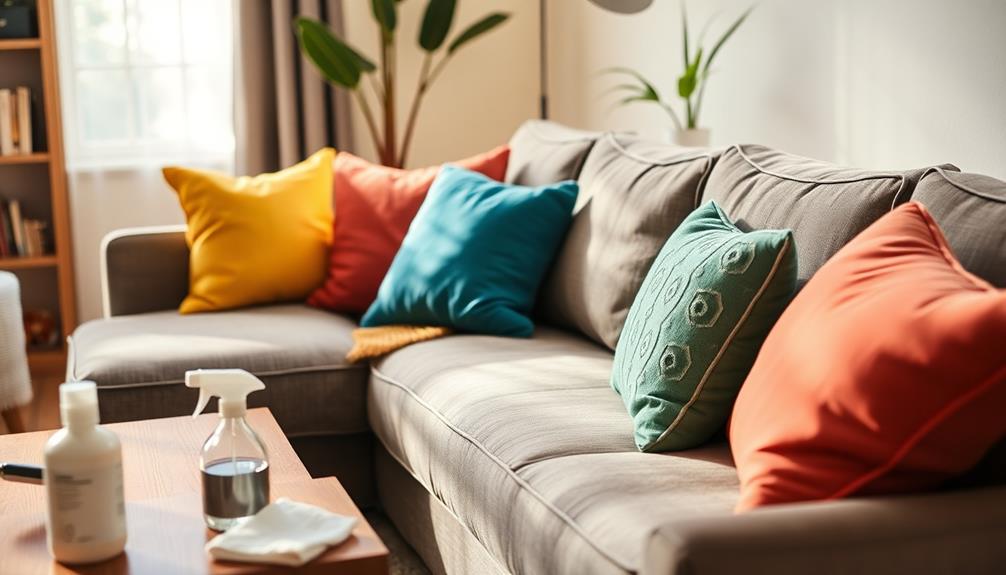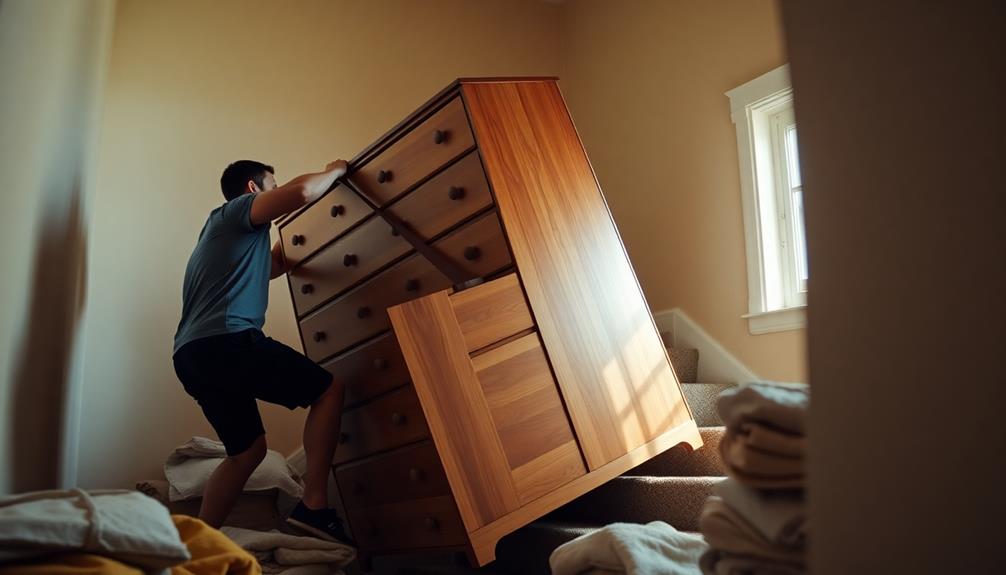To clean your sofa at home using a dry cleaning method, make sure to first check the upholstery care tag to ensure compatibility with the fabric. If it is labelled as a solvent-only “S” fabric, use an appropriate dry-cleaning agent. Before starting the cleaning process, ventilate the area and clear any obstacles. It is important to always perform a spot test on a hidden area to avoid any discoloration. Gently blot stains with a clean cloth and the chosen solvent, then vacuum the sofa to remove any residue. Consistent maintenance, such as promptly treating stains and regular vacuuming, will help keep your sofa looking fresh. Stay tuned for more helpful tips to improve your cleaning routine!
Key Takeaways
- Identify the fabric type using the care tag; ensure compatibility with the chosen dry-cleaning solvent.
- Prepare your cleaning space by ventilating the area and removing obstructions for easy access.
- Conduct a spot test on a hidden area to check for discoloration before applying the cleaner.
- Blot stained areas gently with the appropriate solvent on a clean cloth, avoiding rubbing.
- Vacuum the sofa post-cleaning to remove any residual cleaner and maintain fabric freshness.
Understanding Upholstery Care Tags

When it comes to caring for your sofa, understanding upholstery care tags is essential. These tags provide vital information about your upholstery fabric, helping you choose the right cleaning methods. Common codes include "W" for water-based cleaning, "S" for solvent-only cleaning, and "WS" for both.
If you see a Code S, you need to be especially cautious; using water-based cleaners can damage the fabric. Additionally, choosing the right cleaning method can prevent potential side effects from using the wrong products, similar to how selecting appropriate cold medications is important for effective relief.
Since 1969, the U.S. Federal Trade Commission (FTC) has mandated these care tags, ensuring you have guidance for maintaining your furniture. Before you clean, always consult the care tag to avoid any mishaps.
If your care tag is missing, conduct a test cleaning on a hidden area of the sofa to find the safest cleaning method for your specific upholstery fabric.
Selecting the Right Dry-Cleaning Agent
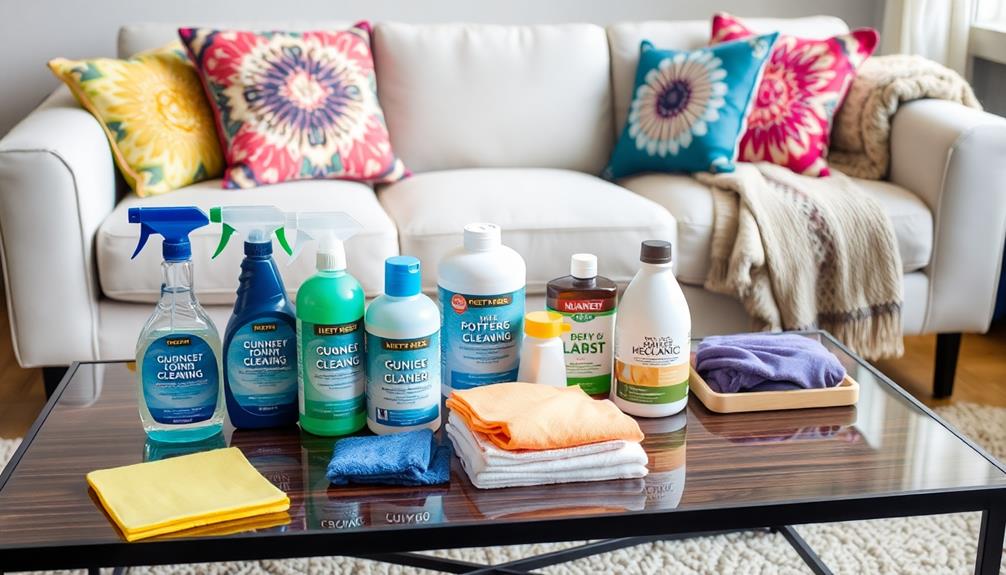
When you're choosing a dry-cleaning agent, it's vital to pick one that matches your sofa's fabric type for the best results.
Consider using natural cleaning solutions like essential oils, as they can provide not only effective cleaning but also essential oils for respiratory health benefits.
You might also want to explore eco-friendly options that clean effectively while being kinder to the environment.
Always remember to check the label for compatibility and instructions before getting started.
Eco-Friendly Options Available
Choosing the right dry-cleaning agent for your sofa can make a significant difference, especially if you're looking for eco-friendly options. Eco-friendly dry-cleaning agents are often plant-based and free from harsh chemicals, making them safer for your health and the environment.
Many essential oils also offer natural cleaning benefits, as some oils, such as tea tree and lavender, have antibacterial properties that can enhance the cleaning process essential oils for skin conditions. When selecting an agent, look for products labeled as biodegradable or non-toxic. These labels indicate that the product minimizes environmental impact while effectively cleaning your upholstery.
Many eco-friendly solvents utilize natural ingredients like citrus extracts or vinegar, which can effectively break down stains without leaving harmful residues. Not only do these agents clean well, but they also contribute to a healthier home environment.
Research and choose brands that have certifications or eco-labels, indicating their commitment to sustainability and environmental responsibility. This extra step guarantees you're using a product that aligns with your eco-conscious values.
Compatibility With Fabric Types
Understanding your sofa's fabric type is essential for selecting the right dry-cleaning agent. Always check the upholstery care tag before you start. If your sofa fabric is labeled with an "S," you should only use dry cleaning solvents. For "W" fabrics, water-based cleaners are safe, while "WS" fabrics allow for both dry-cleaning agents and steam vacuuming, giving you more options.
Regular maintenance, like routine vacuuming, can also help preserve the fabric's appearance and reduce the need for deep cleaning. Additionally, mechanic shops for fuel injection cleaning can provide insights into the importance of professional care for various materials.
If you can't find a care tag, don't worry—just perform a spot test on an inconspicuous area of your sofa. Apply a small amount of the dry-cleaning solvent and monitor for any discoloration or damage. This simple test can save you from potential mishaps.
Additionally, consider eco-friendly dry-cleaning solvents. These alternatives aren't only effective but also gentler on the environment, making them a great choice for various fabric types.
Preparing Your Cleaning Space
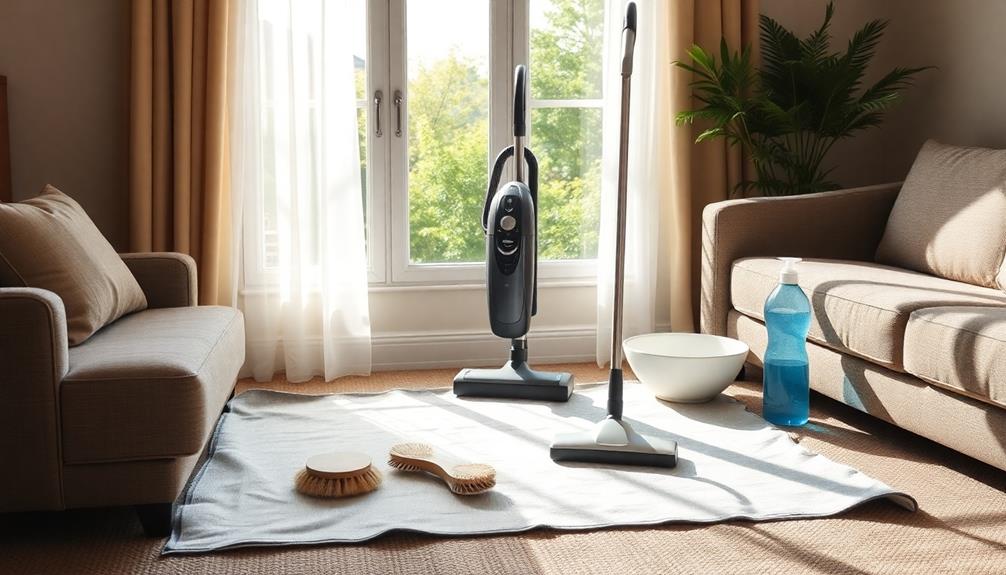
Before you start cleaning, make sure your space is well-ventilated by opening windows and doors to keep the air fresh.
Clear away any clutter that might get in your way, as a tidy area allows for easier movement.
With proper airflow and a clean workspace, you'll be all set to tackle those stains effectively.
Ventilation and Airflow
Creating a well-ventilated cleaning space is essential for safely dry cleaning your sofa at home. Start by opening windows and doors to promote ventilation, allowing fresh air to circulate and dissipate any strong odors from cleaning solvents. You can also use fans to enhance airflow, which helps reduce the intensity of solvent fumes.
To help you set up your cleaning area, refer to the table below:
| Task | Purpose | Tips |
|---|---|---|
| Open Windows & Doors | Increase ventilation | Do this before you start |
| Use Fans | Enhance airflow | Position them strategically |
| Clear Obstacles | Facilitate movement | Guarantee a clutter-free space |
| Maintain Lighting | Improve visibility during cleaning | Use bright, natural lights |
| Limit Pets & Kids | Guarantee safety | Keep them in another room |
While cleaning, use a clean white cloth for spot-checking stains and guaranteeing your sofa remains in pristine condition. Allow the sofa to air dry completely after cleaning, as good ventilation will help speed up this process.
Clearing the Area
To effectively prepare your cleaning space for dry cleaning your sofa, start by clearing away any furniture or decor that might block your access. This step is vital for a smooth and efficient cleaning process.
According to discussions in the Reddit community, creating a secure environment is important, as it guarantees you can focus on your task without distractions increased safety and peace of mind.
Once you've cleared the area, make certain to open windows and doors to guarantee proper ventilation. Dry-cleaning solvents can have strong odors, and fresh air will help dissipate those smells.
Using fans to circulate air throughout the space not only reduces the solvent smell but also speeds up drying time.
With the area now clear, guarantee it's well-lit. Good visibility allows you to spot stains effectively, ensuring thorough cleaning.
Before you begin the actual cleaning, place a drop cloth or old towels on the floor beneath the sofa. This protective layer will catch any drips or spills from your cleaning product, safeguarding your flooring from damage.
Performing a Spot Test
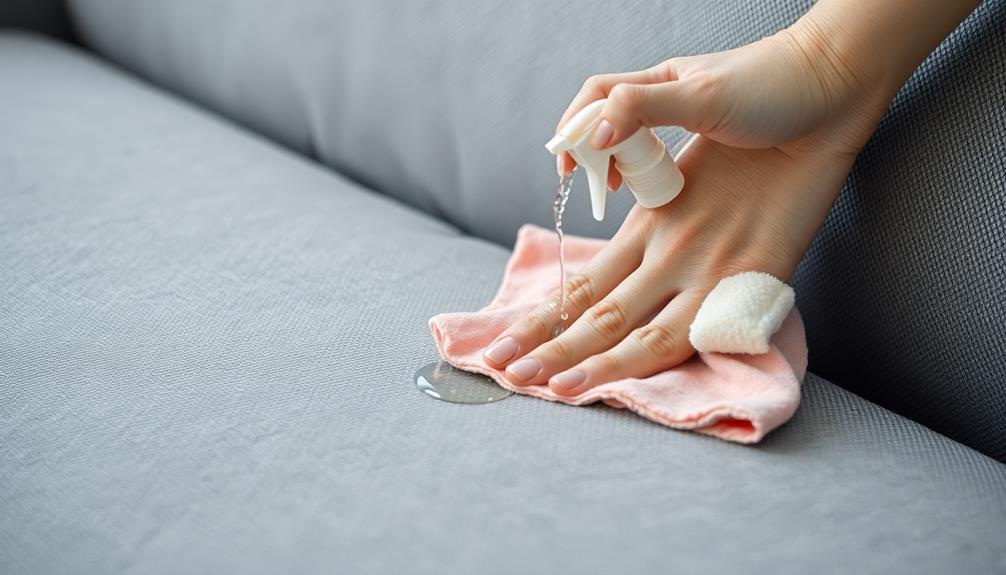
Perform a spot test to ascertain your chosen dry-cleaning solvent won't damage your sofa's fabric. Start by applying a small amount of the solvent onto a clean rag.
It's vital to test on a hidden area of the sofa, like the underside or back, to check for any potential discoloration or adverse reactions before you dry clean your sofa. Regular maintenance of your furniture can help extend its lifespan, similar to how preventive maintenance plans can keep appliances running smoothly.
After applying the solvent, wait a few minutes following the cleaner's guidelines. This waiting period is important; it allows the solvent to interact with the fabric.
Once the time is up, inspect the test area for any changes. Look closely for discoloration or any other signs of damage. If you notice discoloration, discontinue use of that solvent immediately and select a different one.
Always confirm the fabric type is compatible with the dry-cleaning solvent you choose. This simple step could save you from making costly mistakes and guarantee your sofa stays looking great.
Step-by-Step Sofa Cleaning
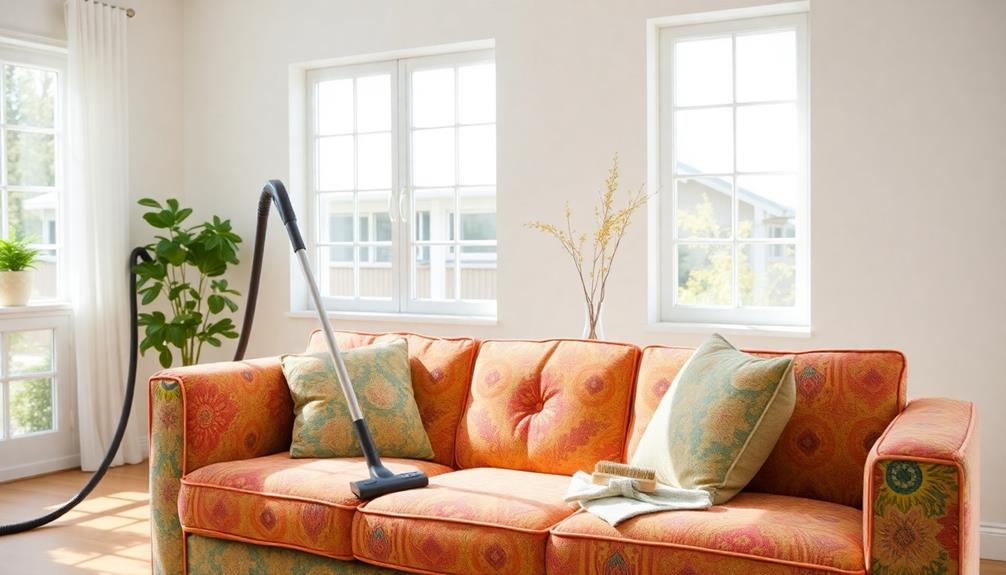
Once you've confirmed that your chosen solvent is safe for your sofa, you can begin the cleaning process.
Start by preparing your cleaning environment. Open windows for ventilation, remove any obstructions, and gather your tools: a vacuum, cleaning solvent, and clean, white rags. For a thorough cleaning experience, verify that the air quality is ideal by using an air purifier; this can help reduce allergens and dust in the environment, making your cleaning process more effective Air Purifier Maintenance Dos and Don'ts.
Next, perform a spot test by applying the solvent to an inconspicuous area of the sofa. This step checks for any discoloration or adverse reactions. If everything looks good, proceed to spot clean the stains.
Take a clean dry cloth and apply the dry-cleaning solvent to it. Gently blot the stained areas without rubbing, as this could damage the fabric. Allow the cleaner to dry completely before moving on.
After you've cleaned the stains, vacuum the sofa to eliminate any residual cleaner. This helps restore the fabric's texture and appearance.
To protect your upholstery, consider applying a fabric-protecting spray. This simple step can help extend the lifespan of your sofa, verifying it looks great for years to come.
Enjoy your freshly cleaned sofa!
Stain Removal Techniques

Act quickly when a stain occurs on your sofa to prevent it from setting. The faster you act, the better your chances of keeping your upholstery looking fresh. Here are some effective stain removal techniques to try: Additionally, keeping a best vacuum for dust removal nearby can help maintain your sofa's cleanliness and minimize the risk of stains.
- Blot the area with a clean, absorbent cloth immediately to soak up any liquid. Always work from the outside edges inward to prevent the stain from spreading.
- For greasy stains, sprinkle cornstarch on the affected area to absorb excess oil. Let it sit for 15-20 minutes before vacuuming it up.
- If you're dealing with ink or grease, use rubbing alcohol sparingly on a clean cloth. Test it on an inconspicuous spot first to prevent discoloration.
- Mix mild dish soap and water to tackle food or drink spills. Apply gently and rinse with a damp cloth to remove any residue.
- Always allow any cleaning solutions to dry completely before using the sofa again. This helps prevent dirt accumulation and mold growth.
Maintenance Tips for Upholstery
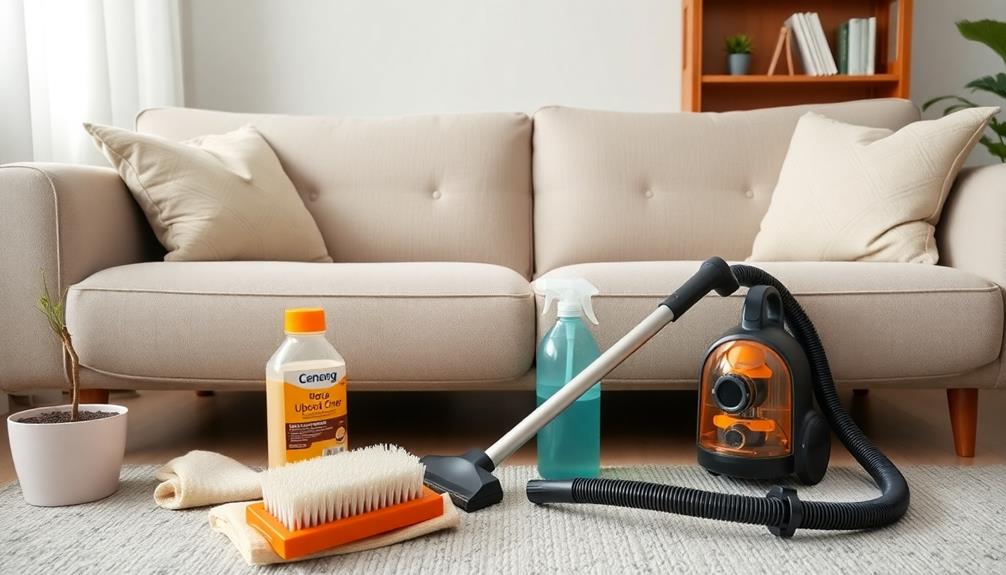
Keeping your upholstery in top shape requires regular attention and care. Start by vacuuming your fabric sofa at least once a month to eliminate dust, debris, and allergens. This simple step helps maintain a clean appearance and prolongs the fabric's lifespan.
When spills happen, treat them promptly to prevent stains from setting in. Always refer to the care tag for the best cleaning methods specific to your upholstery. Additionally, consider the impact of pet care on your furniture, as routine health checks for signs of illness can help minimize accidents that may lead to stains.
Twice a year, ideally in the spring and fall, conduct thorough cleaning sessions to refresh your sofa and remove any built-up dirt and odors. After cleaning, consider applying fabric-protecting sprays to create a barrier against future spills and stains, enhancing the durability of your upholstery.
Don't forget to rotate your cushions periodically. This practice promotes even wear and prevents flattening, ensuring your sofa maintains its shape and comfort over time.
When to Seek Professional Help
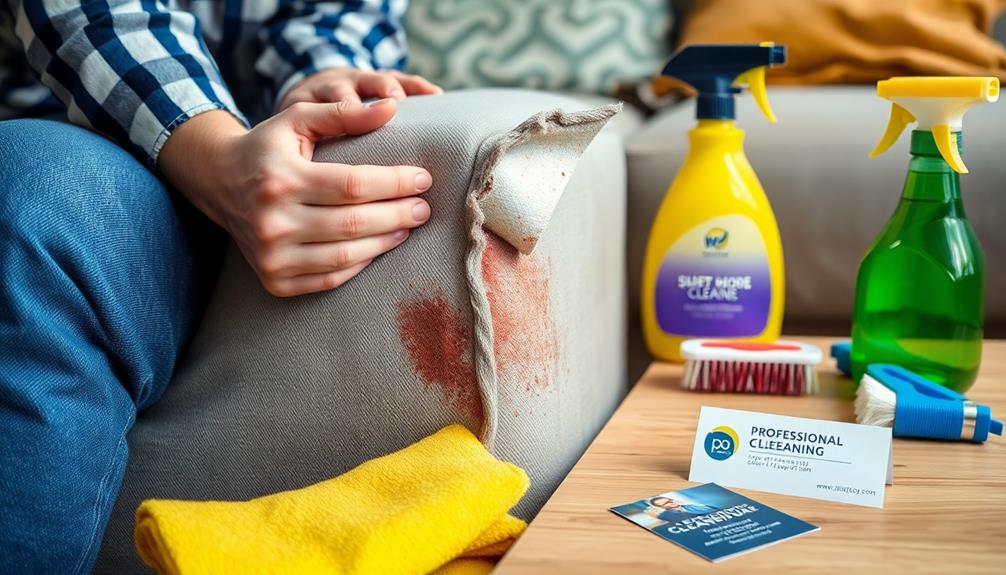
Knowing when to seek professional help for your sofa can save you time and prevent damage. While home cleaning can be effective, certain situations call for the expertise of professionals. Individuals with Borderline Personality Disorder (BPD) may struggle with impulsive decisions, leading them to overlook the need for professional care when tackling tough cleaning challenges.
Here are key instances when you should consider reaching out for help:
- Your care tag indicates "X," meaning no cleaning method is recommended.
- You have delicate fabrics like silk or velvet that require specialized care.
- Stains persist even after multiple at-home cleaning attempts.
- You're dealing with a large or heavy sofa that's tough to maneuver.
- There's a significant buildup of allergens, dust mites, or odors that home cleaning can't eliminate.
In these cases, professional cleaners possess the right tools and techniques to handle your sofa safely and effectively. They can address stubborn stains and guarantee that your delicate fabrics are treated properly, minimizing the risk of damage.
Additionally, they can provide thorough sanitation, which is especially important if your sofa has accumulated allergens. Don't hesitate to call in the pros when the situation demands it—your sofa will thank you!
Frequently Asked Questions
Can You Dry Clean a Sofa at Home?
Yes, you can dry clean a sofa at home if the care tag allows it. Just make certain to use the right solvent, test a hidden spot first, and guarantee good ventilation while cleaning.
How Do You Clean a Dry Clean Only Couch?
To clean a "dry clean only" couch, identify the fabric type, spot test a solvent, gently blot stains with a clean cloth, air dry, and vacuum regularly to maintain its appearance.
How Do You Clean a Fabric Couch Without Washing It?
Ever spilled something on your couch during movie night? To clean it without washing, vacuum thoroughly, use a suitable fabric cleaner, gently blot stains, sprinkle baking soda for odors, and let it air dry.
What Is the Best Way to Clean a Fabric Sofa?
To clean your fabric sofa, start by checking the care tag. Vacuum it thoroughly, then spot clean stains with a suitable upholstery cleaner, blotting gently. Regular maintenance helps keep your sofa looking fresh and inviting. Avoid soaking the fabric, as this can lead to water stains or damage. For deeper cleaning, consider steam cleaning or hiring a professional upholstery cleaner. By understanding **how to clean a fabric sofa** properly, you’ll extend its lifespan and maintain both its comfort and appearance.
Conclusion
Now that you know how to clean your sofa at home, imagine sinking into a freshly cleaned, inviting seat. But what if a stubborn stain ruins your plans? Don't let that happen! With the right techniques and a bit of care, you can keep your upholstery looking its best. Remember, if you ever feel overwhelmed, calling in the pros can be your safety net. Keep that cozy comfort alive—your sofa deserves it!
